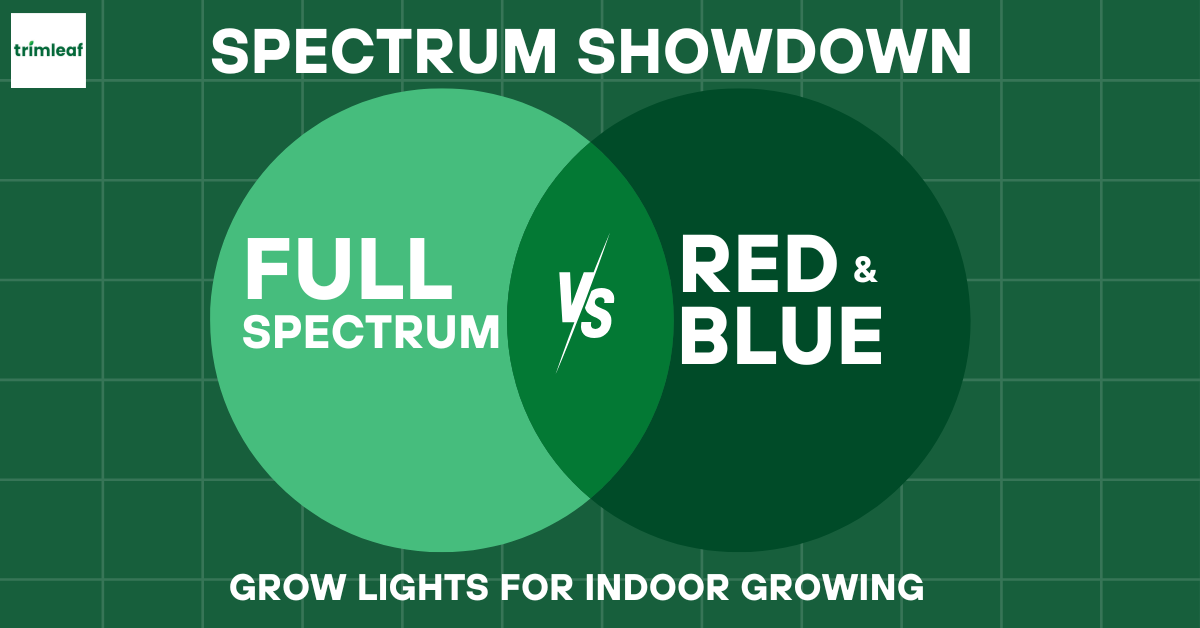
Choosing the right grow light is crucial for the success of your indoor garden.
With full-spectrum and red and blue LEDs dominating the market, it’s easy to feel torn between these two popular options. Each type of light offers unique benefits and potential drawbacks, and understanding how they impact plant growth is key to making the best choice for your setup.
Table of Contents
Understanding the Basics of Grow Light Spectrums
Light plays a vital role in the growth of plants, specifically in the process of photosynthesis. Plants absorb light through pigments like chlorophyll, and different wavelengths within the light spectrum promote different phases of growth.
While plants rely heavily on red and blue light for photosynthesis, the entire spectrum of light is important for their development.
What is a Light Spectrum?

The light spectrum refers to the range of wavelengths emitted by a light source, from ultraviolet (UV) to infrared (IR). The range most beneficial to plants is called Photosynthetically Active Radiation (PAR), which covers wavelengths between 400 and 700 nanometers (nm).
This range includes the violet, blue, green, yellow, orange, and red light that plants need for processes like leaf growth, stem elongation, and flowering.
What is Full Spectrum Light?

Full spectrum grow lights mimic the full range of sunlight, covering all wavelengths within the PAR range. These lights provide a balanced distribution of colors, ensuring that plants receive the full spectrum of light needed throughout their lifecycle.
Full spectrum lights offer blue light for vegetative growth, red light for flowering, and additional wavelengths that contribute to overall plant health, such as green and far-red.
Because these lights replicate sunlight, they are ideal for indoor growers who need a light source that can support multiple stages of plant growth, from seedling to harvest. Full spectrum lights are also great for mixed gardens with different plant types, each requiring different light intensities.
What Are Red and Blue Grow Lights?

Red and blue grow lights, often called "purple lights," are focused on the two key wavelengths: blue (400–500 nm) and red (600–700 nm), which are crucial for photosynthesis.
- Blue light is essential for the vegetative phase, promoting strong leaf and stem growth.
- Red light is vital for flowering and fruiting, encouraging plants to bloom and produce fruit.
These grow lights are energy-efficient because they concentrate on the most effective wavelengths for plant growth. However, they may lack the full spectrum of light needed for overall plant health and development.
Pros and Cons of Full Spectrum Grow Lights
One of the key features of full spectrum grow lights is their ability to replicate natural sunlight, making them ideal for plants throughout their entire growth cycle, from seedling to flowering. This ensures that plants can photosynthesize as they would outdoors, promoting healthier, more natural growth.
Pros of Full Spectrum Grow Lights
Full-spectrum lights cover a broad spectrum of wavelengths, making them suitable for diverse plant types and growth stages.
Full-spectrum lights can provide consistent support for all phases. This simplifies your setup, making it easier to manage your indoor garden.
Cons of Full Spectrum Grow Lights
Full spectrum lights tend to be more expensive than red and blue lights.
For plants that only require specific wavelengths, like leafy greens during vegetative growth, full-spectrum lights can be overkill.
Full spectrum lights generally consume more power due to the wider range of wavelengths they cover.
Pros of Red and Blue Grow Lights
Red and blue grow lights are best for small-scale gardeners or those focused on specific stages of growth, such as vegetative or flowering. They are energy-efficient and cost-effective, making them a great choice for hobbyists or growers working with a limited number of plants.
Pros of Red and Blue Grow Lights
Tailored Spectrum for Growth Phases
Red and blue grow lights focus on the most critical growth phases—blue light for the vegetative stage and red light for flowering.
More Energy-Efficient and Cost-Effective
These lights are designed to be more energy-efficient than full spectrum options, making them more cost-effective for smaller setups.
Simple Setup for Small-Scale Growers
Red and blue lights are ideal for small-scale indoor gardens. They offer a focused solution that’s perfect for growers with limited space, such as small grow tents or windowsills.
Cons of Red and Blue Grow Lights
While red and blue lights are essential, they may lack other important wavelengths like green, yellow, and far-red, which contribute to balanced plant growth and overall health.
Red and blue lights excel in specific stages of growth but may not be suitable for plants that require balanced light across all stages.
Key Considerations When Choosing Between Full Spectrum and Red and Blue Lights
There are some considerations to take note of when choosing between full spectrum and a combination of red and blue grow lights.

Plant Type and Growth Stage
Consider the type of plants you are growing. Full spectrum are ideal for a wide range of plants, including leafy greens, herbs, and flowering plants, supporting all growth stages. Red and Blue Lights are best for specific growth phases, such as promoting strong foliage with blue light or encouraging flowering with red light.
If you are growing herbs and leafy vegetables, you might not need a full spectrum, unless you have other plants to grow.
Yield Expectations
Full Spectrum Lights often lead to higher yields because they support all stages of growth, leading to healthier, larger plants. While Red and Blue Lights can help plants grow quickly during specific phases, they may limit overall yield due to their narrower spectrum.
Energy Efficiency
Full Spectrum Lights tend to consume more energy, making them less cost-effective in smaller setups. However, newer models are designed to be more energy-efficient. Red and Blue Lights, meanwhile are more energy-efficient due to their focused light spectrum, making them a cost-effective option for smaller, energy-conscious setups.
Conclusion
Both full-spectrum and red and blue grow lights offer distinct advantages, depending on your indoor gardening needs. Ultimately, the right choice comes down to your unique gardening needs. Choose the grow light that best aligns with your space, budget, and goals, and watch your plants thrive.
Ready to choose the perfect grow light for your garden? Explore our wide range of full spectrum and red and blue grow lights to find the ideal match for your plants and help them flourish.
Learn more about grow lights here:
- All About Grow Lights for Indoor Plants
- LED Grow Lights: A Comprehensive Buyer's Guide
- The Best 4x4 LED Grow Lights
- Best LED Grow Lights (2024)
- How Does the Grow Light Spectrum Influence Cannabis Growth?
- Grow Lights: How Many Watts Per Plant/Square Foot is Needed?
- Pay Attention to These Things When Buying LED Grow Lights
Frequently Asked Questions About Grow Light Spectrums
- ◄What are the primary wavelengths of light that plants utilize for photosynthesis?
- Plants primarily utilize red and blue light for photosynthesis.
- ◄What are the key differences between full spectrum and red and blue grow lights?
- Full spectrum lights mimic the entire range of sunlight, including all wavelengths in the PAR range. Red and blue grow lights focus on the two key wavelengths (red and blue) essential for photosynthesis.
- ◄When are full spectrum grow lights most beneficial?
- Full spectrum lights are ideal for indoor growers who need a light source that can support multiple stages of plant growth, from seedling to harvest. They are also great for mixed gardens with different plant types.
- ◄In what situations are red and blue grow lights preferred?
- Red and blue grow lights are best for small-scale gardeners or those focused on specific stages of growth, such as vegetative or flowering. They are energy-efficient and cost-effective.
- ◄How does the size of your indoor garden influence your grow light choice?
- Larger gardens may require more powerful grow lights or multiple lights. Smaller gardens can use less powerful lights.
- ◄What types of plants are you growing, and how do their light requirements differ?
- Different plants have varying light requirements. Some plants prefer low light, while others require high light intensity.
- ◄What is your budget for grow lights?
- Consider your budget when choosing a grow light. Full spectrum lights tend to be more expensive than red and blue lights.
- ◄How important is energy efficiency to you?
- Red and blue grow lights are generally more energy-efficient than full spectrum lights.
- ◄Do you prefer a hands-off approach or do you enjoy customizing your grow light setup?
- Full spectrum lights offer a more hands-off approach, while red and blue lights allow for more customization of light intensity and duration.




